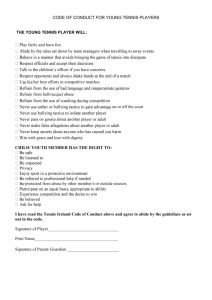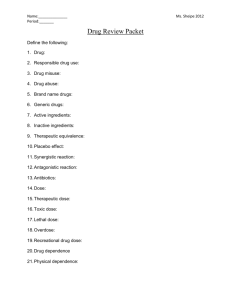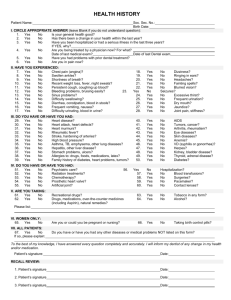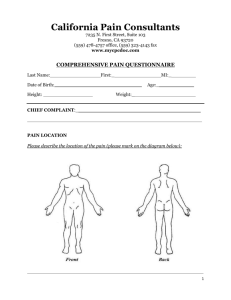Medical Office Lesson 5 Practice Quiz
advertisement
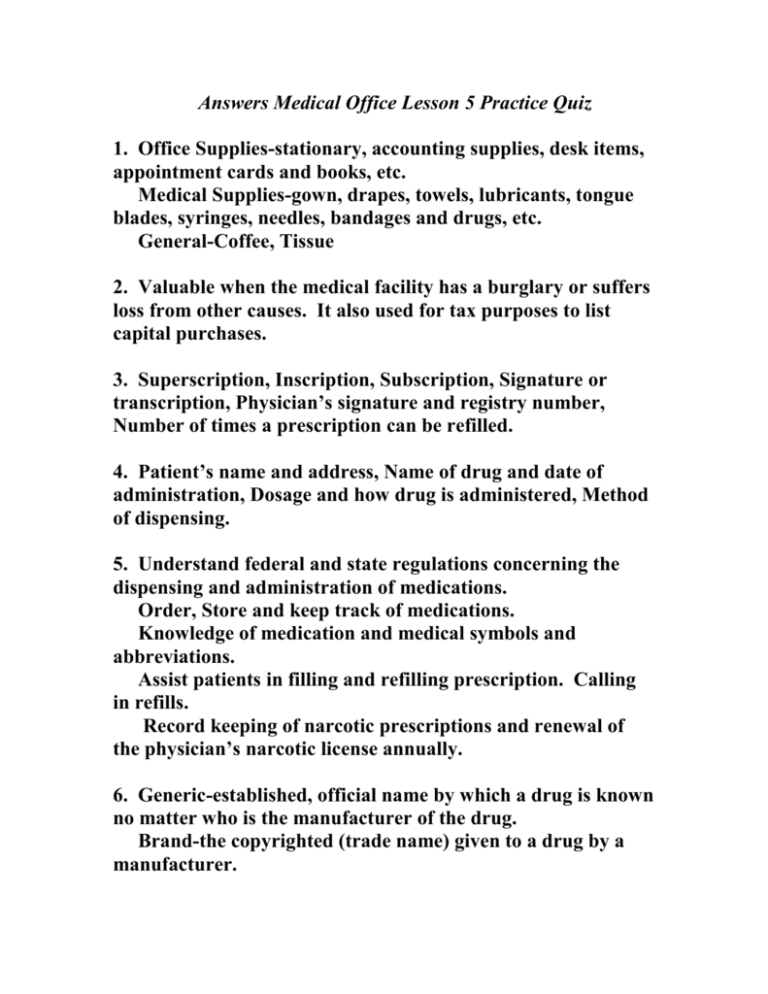
Answers Medical Office Lesson 5 Practice Quiz 1. Office Supplies-stationary, accounting supplies, desk items, appointment cards and books, etc. Medical Supplies-gown, drapes, towels, lubricants, tongue blades, syringes, needles, bandages and drugs, etc. General-Coffee, Tissue 2. Valuable when the medical facility has a burglary or suffers loss from other causes. It also used for tax purposes to list capital purchases. 3. Superscription, Inscription, Subscription, Signature or transcription, Physician’s signature and registry number, Number of times a prescription can be refilled. 4. Patient’s name and address, Name of drug and date of administration, Dosage and how drug is administered, Method of dispensing. 5. Understand federal and state regulations concerning the dispensing and administration of medications. Order, Store and keep track of medications. Knowledge of medication and medical symbols and abbreviations. Assist patients in filling and refilling prescription. Calling in refills. Record keeping of narcotic prescriptions and renewal of the physician’s narcotic license annually. 6. Generic-established, official name by which a drug is known no matter who is the manufacturer of the drug. Brand-the copyrighted (trade name) given to a drug by a manufacturer. 7. DEA (Drug Enforcement Agency) 8. Controlled Substances Act of 1970 9. Drug reference textbook (Physician’s Desk Reference) 10. Schedule I: drugs of high potential for abuse and that have no current accepted medical use. Schedule II: drugs that have current accepted medical use in the US but with severe restrictions. Drugs with high potential for abuse that may lead to severe psychological or physical dependence. Schedule III: drugs with less potential for abuse than substances in Schedule I & II. They have accepted medical uses in the US, but may lead to moderate or low physical dependence or high psychological dependence. Schedule IV: drugs have a lower potential for abuse than those listed in Schedule III and have accepted medical uses in the US, but their abuse still may lead to limited physical and psychological dependence. Schedule V: drugs with less potential for abuse than drugs in Schedule IV, and their abuse may be limited to physical or psychological dependence. 11. Do not give advice about medications, Do not dispense medications, Do not administer medications. 12. Checking and Savings Accounts. 13. Cashier’s check-Bank’s check drawn against itself and signed by a bank official. Certified check-Patient’s own check with CERTIFIED or ACCEPTED written across the face of the check. The bank will guarantee that the check is good. Money order-Same as cash. Can be purchased from post office, gas stations, etc. Bank draft-Check that is a written order to pay funds drawn by a bank on its account at another bank. Traveler’s check- For travelers. Two signatures are required on checks, Denominations of $10, $20, $50, and $100. Limited check-Limited as to the amount of the check as well as the time during which it can be cashed. Voucher check-Has a detachable form that is used to notate the purpose for which the check is written. The form is taken off before deposit. Warrant-Check that cannot be cashed but is evidence of a debt due. 14. NO 15. Withdraw this payment from the patient’s account. This amount is now due in addition to a returned check fee. Contact the patient advise him/her of the returned check. Arranged a time that the patient will come by a pay you IN CASH the amount of the return check plus the returned check charge. Give the patient the total amount due (check + return charge) when you call to inform about check. Give approximately 5 working days to pay for this returned check plus all fees. After 5 days send a collection letter. 16. Magentic Ink Character Recognition. Numbers and characters printed in this ink representing a machine language. 17. Types of Endorsements: Blank, Restrictive, Special 18. Check the signature on the credit card against the credit signature on the card and slip. Be sure the name on the credit card is the same as the bearer’s name, Check expiration date on the card. Complete a credit card charge slip detailing the charges. Using an automatic credit card machine “swipe” the card. Enter amount to be charged. If approved write down on charge slip- authorization number and reference number. Have patient sign the slip and return charge card. Patient will retain top copy of charge slip. 19. Add up Encounter Forms. Add up monies in drawer minus your petty cash. Run total off computer software. All should balance with the same totals. If you are not balancedmatch up the monies with the appropriate encounter form check that against the computer printout and find error. Prepare deposit slip. List every check number and amount on slip. Remember do not deposit charge card slips. That money will be coming later from credit charge company. Once deposit is complete put in appropriate bank bag and given to practice manager. 20. Four years by tax law 21. Seven years by tax law 22. Accounts Payable-Amounts the practice owes to others, etc. Accounts Receivable-Amounts owed to the practice for services. 23. Single Entry, Double Entry, Pegboard, Computerized bookkeeping. 24. Employees that handle cash may be bonded. An insurance or bonding company guarantees payment of a specified amount to an employer in the event of financial loss caused by an employee. 25. FICA: Federal Insurance Contribution Act OR Social Security. 26. W-4: Withholding allowance certificate. Number of exceptions to be claimed. W-2: Wage and earning statement from employer. 27. Internal billing: billing handled in the health care facility. External billing: outside service handles patient accounts. 28. Payment at Time of Service, Credit Card Billing, Transaction Record, Computerized statement 29. Fair Credit Opportunity Act, Equal Credit Opportunity Act, Federal Truth in Lending Act. 30. Collection letter, Telephone Collections, Dun Messages, Collection Agencies. 31. Practice can file a proof-of-claim form available from an attorney, county clerk’s office, etc.



